To excel in any environment—school, work, or athletics, to name a few—it helps to have a clear and mutual understanding of the expectations between involved parties. When expectations are vague and not explicitly spelled out, it can make evaluation stressful and receiving feedback a frustrating experience.
In the context of the classroom, expectations are often set at the state and national level. These expectations are called “standards,” critical benchmarks for learning that are specific to each subject and grade level. Standards encompass the mastery of many smaller learning tasks generally referred to as “learning goals.” Learning goals are shared with the students during lessons and help to break standards into more manageable chunks.
When it comes time to evaluate a student on a performed task, most of us know that giving them a “pass” or “fail” won’t be a meaningful representation of what was accomplished, or enough feedback to prompt learning. Students complete tasks as unique individuals across a spectrum of performance levels ranging from exceeding expectations of the learning goal to not meeting expectations at all.
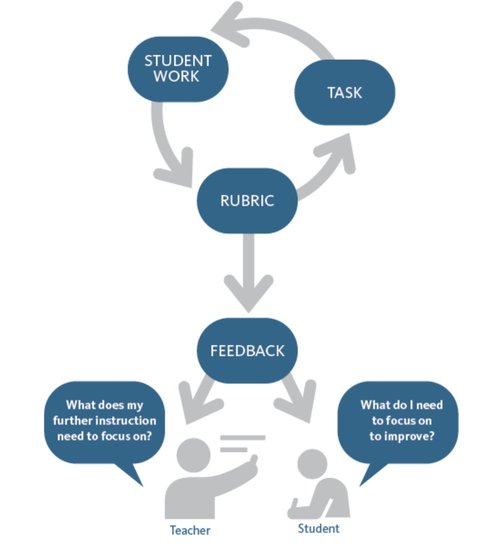
Rubrics were designed to be an answer to this problem for teachers and students. Rubrics are used to evaluate work and assign scores based on a student’s ability to meet expectations across a continuum of performance benchmarks. While most teachers view rubrics as a helpful tool for setting expectations and assigning scores based on a student’s ability to meet those expectations, rubrics are often underutilized as a tool in the learning process.
Ultimately, students need to learn from their work—from what they did well just as much as where they fell short. Students should be improving every time they complete a task and should know what goals they are striving towards. Teachers help students learn from their work by providing them with feedback.
Decades of research has shown that feedback is among the most powerful tools teachers can use to help students work towards, reach, and ultimately exceed expectations in any given task. However, not all feedback is created equal (see our Ultimate Guide to Feedback). Highly effective feedback is goal-oriented, prioritized, and actionable—and therefore directly linked to the expectations set in the rubric.
By following these three steps, you will be able to more intentionally use rubrics to improve the quality of your feedback and therefore create measurable improvements in student outcomes.
- Use the rubric to remain objective and goal-oriented in your feedback.
As a former teacher, I like to think that I was able to objectively evaluate my students’ work free from the influence of bias. However, as I reflect on my experience, it is quite clear to me that this was not the case. Some of my students were homeless, some were non-native English speakers, and some were, simply, disinterested. This led me to be lenient in my grading on more than a few assignments. At the time, I thought I was being understanding and kind—I had no idea that what I was doing was, in fact, lowering expectations.
I’m sure you’ve had these same thoughts at some point when grading or leaving feedback on student work:
“I think what this student meant was _______, so I’ll give them the point”
“I really liked how you did ________, nice job!”
You get the idea.
The issue with these comments is that they are subjective. If you noticed, both of these examples contain “I”. However, these comments should have nothing to do with me. It shouldn’t matter who is evaluating the students’ work—whether it is the students’ primary teacher, another student, a different teacher in a different state, or a grader. (graders, by the way, are highly effective, remote grading assistants at Marco Learning).
“Students should always be evaluated objectively based on how well they are able to respond to the objectives of the assignment and craft their work in accordance with the expectations of the rubric.”
Using a rubric when evaluating student writing will not only hold you accountable to remain objective but will also clearly lay out expectations for students. It is best practice to introduce your students to rubrics early in the school year and remain consistent with their use. Using rubrics is a skill in itself, so don’t expect students to be able to effectively use a rubric after simply handing it out the first time.
Here is an example of subjective feedback (orange) and objective feedback (yellow). You’ll notice that subjective feedback starts with “I”, and the objective feedback keeps the focus on the expectations of the rubric as opposed to the expectations of the evaluator. Always make sure to align your feedback to the rubric, rather than to your opinion.
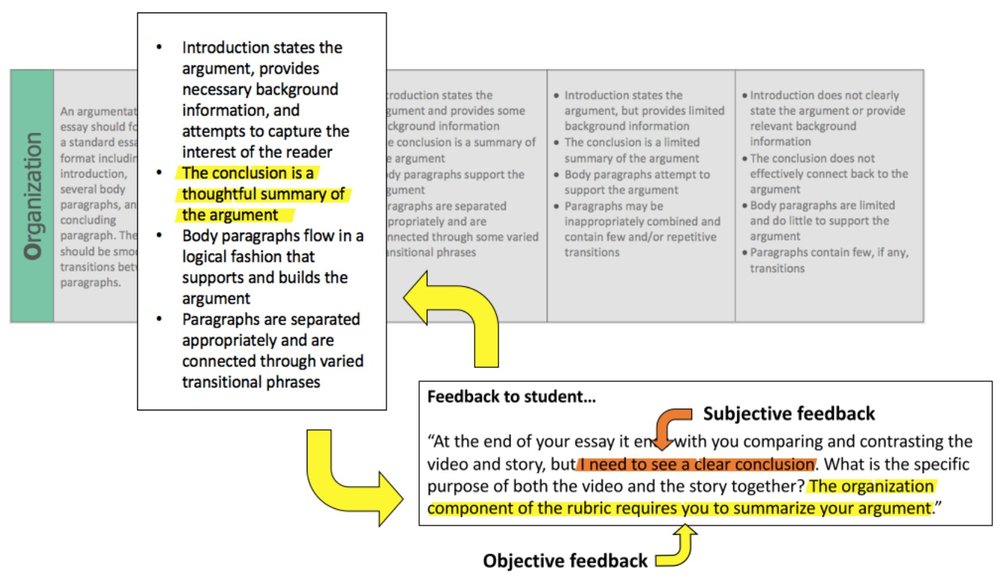
One of the many reasons teachers love our graders is that they bring an objective, third-party perspective to the evaluation student work.

Teacher tip: While using a rubric can help you be more objective in your scoring and feedback, you’re still affected by biases if you know which student you are evaluating. To mitigate the harmful effects of bias, you can have your students draw random numbers or use their student ID numbers instead of their name when submitting work. This will help your students remain anonymous while you grade and provide feedback
- Use the rubric to help you prioritize your feedback for students.
Highly effective feedback should be prioritized. This means that your comments should be focused on the two to three areas of strength and two to three areas for growth that will have the most significant impact for the student moving forward. Sometimes, especially when faced with a piece of student work that significantly misses the mark, it can be challenging to identify which areas of growth to prioritize in your feedback to the student. This is where rubrics can be extremely helpful. After objectively scoring the student’s work using the rubric, identify the categories that scored the lowest. These categories may be the best areas to focus your comments, as they provide the greatest opportunity for improvement for the student.
You should also consider if there are certain learning goals of the assignment you wish to emphasize more than others. For example, if students have been working a lot in class on incorporating evidence into their writing, and the prompt for the assignment calls for students to provide textual evidence, this learning goal should be reflected in the rubric and prioritized in your feedback to students.
In the rubric framework we use at Marco Learning, Purpose, Organization, Development, Style (PODS), the Purpose category of the rubric is focused on meeting the objectives set out in the assignment’s prompt. This makes it easier to use the same rubric for many different types of writing assignments, while not losing the important connection to the particular objectives of each assignment. For more information on our PODS framework and to access the rubrics, see the “Rubric Note” at the conclusion of this post.
Here is an example where the student struggled to meet expectations in the Organization component of the rubric. Therefore, this is where the grader focused their feedback. You’ll notice that the grader used the same language that is present in the rubric description to help guide the student from where they currently are toward mastery. This is extremely important, as it will help expectations remain consistent for students.
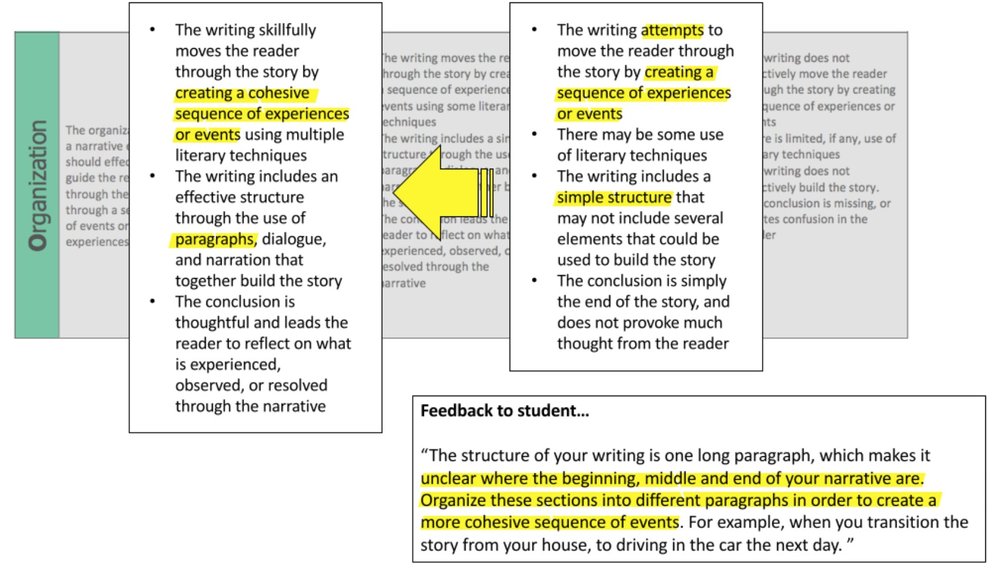
- Use the rubric to help make your comments actionable for the student.
The ultimate goal of providing students with feedback is that it will lead to a measurable improvement in their performance. For a student to improve, they must take some action upon receiving feedback. This action, and the purpose behind it, must be clear to the student. Rubrics are especially helpful for accomplishing that.
“Referencing the rubric either directly or indirectly in your feedback will establish a clear connection between what the student did, what they need to do next, and how to do it.”
You should lean on the rubric to guide your comments. Don’t reinvent the wheel! For example, you could say, “In order for you to meet expectations in the Development component of the rubric, you should not only include a counterclaim but also appropriately address it.” From there you could go on to ask probing questions that would help the student appropriately address the counterclaim, or be more specific as to what it means to address a counterclaim in the first place.
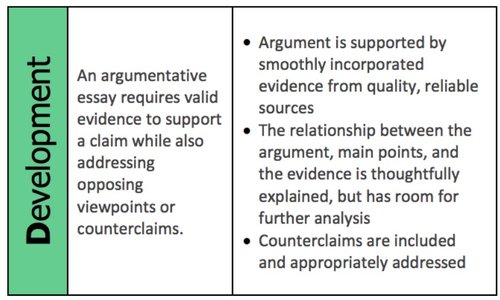
In this example, I directly reference the rubric by saying “…the Development component of the rubric”, and I also indirectly reference the rubric by using the same words from the rubric such as “include”, “counterclaim”, “appropriately”, and “address”.
Often, evaluators will use synonyms for the rubric verbiage in their feedback. However, this can cause confusion and unintentionally set new expectations that were previously not communicated. Establishing common language between teachers and students is a critical part of maintaining consistency in expectations.
Here is another example of how a grader mirrored the language from the rubric in order to make their comments clear and actionable for the student. You’ll notice that the grader also included specific references to the student’s writing—this makes the feedback personalized and creates clear action steps for the student.
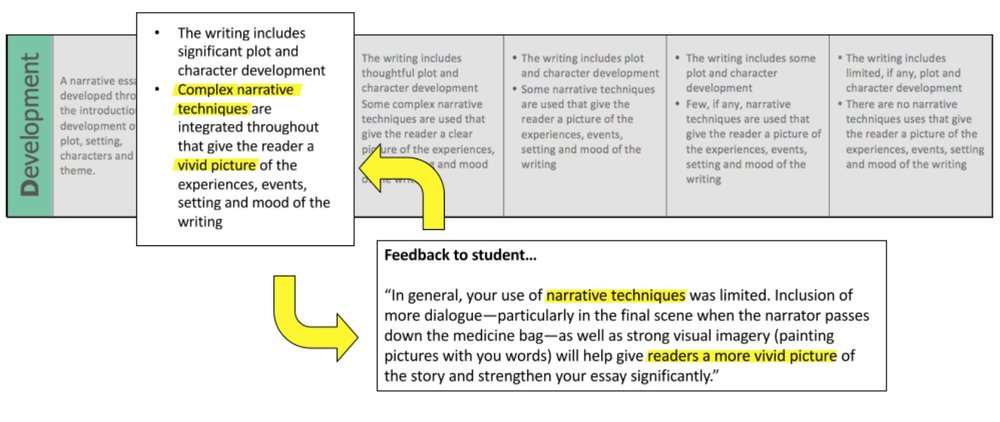
Parting Thoughts
The next time you give students a writing assignment, spend some time up front reviewing the rubric with your class. Make sure that everyone understands the expectations articulated in the rubric, and check that there is no confusion regarding the language used for each scoring level. This is a great opportunity to go over examples of work that meet the expectations of different scoring levels in order to provide clarity for students. There are a variety of activities you can design to help students become more familiar with what quality work looks like—maybe we will create one for a future post! (give us a shout – we take requests)
When you use the rubric to set clear expectations, remain objective, prioritize your feedback, and explicitly connect your feedback to the expectations, your students will be able to measurably improve each time they have an opportunity to work on a writing assignment. Remember—it is crucial to provide students with an opportunity to revise their work or apply their skills towards a similar task after they receive feedback on an assignment. Consistency is key to dramatic improvements in student writing!
If you struggle to consistently assign, score, and provide feedback on student writing due to a lack of time, give us a call. We know all about the “paper load”. Our mission is to provide more personalized feedback to students and more data to teachers on formative writing assignments. We’d love to partner with you and your classroom and, together, help students become better writers.
Rubric note: The rubrics featured in this post are Common Core State Standards aligned rubrics developed by Marco Learning. They use a framework we call “PODS”, which stands for Purpose, Organization, Development, and Style. Each rubric in the series uses these four components, which promotes consistency in language and expectations across assignments.
If you would like to print out these rubrics to use in your class, please do! They are available for free. We hope you enjoy them! Look for new PODS rubrics for different assignments, grade levels, and subject areas each month.
 Help
Help